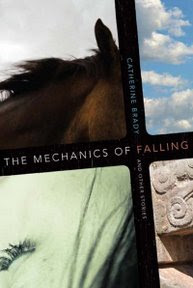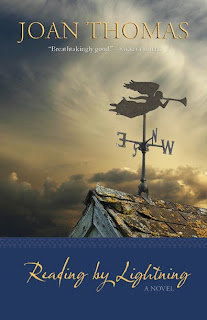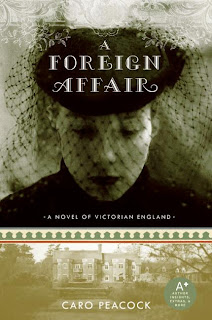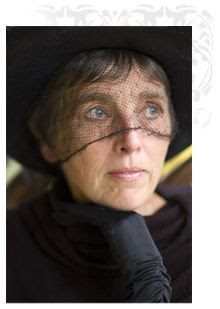
About the Book (From Hachette Website):
On a summer day in 1946 Sally Werner, the precocious young daughter of hardscrabble
At more than 400 pages, Joanna Scott’s Follow Me is a very detailed account of Sally Werner’s background as told by her granddaughter, Sally. Scott has a gift for detail, which can become a drawback when Sally Werner is wandering in the woods after leaving her baby with her parents. The twists and turns Sally’s life takes are driven by her fear and her desire to fit in without revealing her true self in each new location, but often the poetic prose gets in the way. It isn’t until page 53 that readers discover Sally has red hair, and readers find this out at the moment when Sally is getting her hair dyed blond. Scott’s writing vacillates from run-on sentences to short fragments, both of which readers may find slow down the plot.
“Running, Running, Running up the jagged slope behind the rows of new corn, over the stone wall, through the woods and meadows. Sting of nettles. Gray sky of dawn. Bark of a startled deer.” (Page 15)
In some cases, the narrative opts for telling the reader what’s going on, rather than showing the action and development through character interaction. Moreover, detailed backgrounds of side characters like Gladdy Toffit are asides that do not propel the plot or character development forward.
“Other days she’d [Gladdy] dress in one of the three rayon skirt-suits she owned, gather bills from the rolltop desk in the living room, and get in the car and drive to the bank in Amity to confer with the person she called her financial adviser. Late in the afternoon she’d come back home to pour her bourbon, urging Sally to join her because, as she claimed, she didn’t like to drink alone.” (Page 119)
Scott introduces Mole into Sally’s life, and that’s when readers will begin to cheer her on, hoping she will take this new opportunity to turn her life around, grab onto her responsibilities, and emerge a stronger woman. When these characters come together, the scene is full of playful tension and drama as he and his friends sit in a room playing Russian Roulette.
“It was similar to a dream, inevitable and natural and illogical. A slanting light shone from the lantern; the radio crackled its song; the river splashed; the crickets chirped; the tension made breathing impossible; the air was so thick the boy could hardly lift his arm, raising the gun to his head in an attenuated motion, the effort exhausting him, drenching him in sweat, the heat of fear turning his pale skin into melting wax.” (Page 104)
About halfway into Follow Me–which as a title works well for this journey type of novel–the drama heats up forcing Sally Werner to make a tough choice, and these scenes were the most vivid and well crafted. These scenes are the most vivid because they propel the plot, they are full of action, and you are right there with Sally in the thick of it, watching how these events bring out her inner strength and how they are bound to impact and force her to take conscious action.
“It meant she had to cover her face, so the next time he hit her his knuckles struck the back of her hand, bouncing her head away from him but not actually hurting her, which only enraged him more, and with a swift movement he yanked her arm away . . . his fist caught her in the mouth, driving into her gullet, shattering bone, filling her vision with a blank darkness that matched the sky.” (Page 206)
“But Sally could guess what the sound signified and looked up in time to catch a glimpse of Leo leaping from the peaked roof above the door. But she didn’t know he had landed on Benny Patterson until she felt her attacker veer backward. He would have pulled her with him if she hadn’t ripped herself free from his grasp. He stumbled, tripped over the corner of the step, and as the cat leaped forward, Leo’s weight exacerbated Benny’s fall; he plunged backward, his feet came out from under him, and his head snapped hard against the brick wall of Potter’s hardware.” (Page 208)
Overall, it takes a long time to be drawn into this book, and readers may have a difficult time getting a fix on Sally Werner’s character. It was hard to feel sympathetic toward her when many of the problems she faces are self-created and she often portrays herself contrary to her own actions. For instance, she considers herself a hard worker and reliable, but she gives birth and leaves her child within 24 hours of bringing him into the world, which is not a prime example of a reliable woman. Scott’s prose is beautiful, but readers can easily lose their footing in the world Scott tells rather than shows her readers. Clearly, Scott is a gifted writer and uses description well to create a vivid scene, but this story may have worked better if it was told in a different way. Those readers who enjoy generational novels and coming of age stories may be interested in this novel unless they have a rough time with overly descriptive novels.
Joanna Scott is the author of nine books, including The Manikin, which was a finalist for the Pulitzer Prize; Various Antidotes and Arrogance, which were both finalists for the PEN/Faulkner Award; and the critically acclaimed Make Believe, Tourmaline, and Liberation. A recipient of a MacArthur Fellowship, a Guggenheim Fellowship, and a Lannan Award, she lives with her family in upstate New York.
Some of the Hachette Group Early Birds Blog Tour Participants:
Peeking Between the Pages
Bermudaonion
My Friend Amy
S. Krishna’s Books
Booking Mama
The Tome Traveller
Diary of an Eccentric
A Novel Menagerie
Necromancy Never Pays
Caribousmom
Drey’s Library
Redlady’s Reading Room
The Burton Review
A Bookworm’s World
Jenn’s Bookshelf
***Giveaway Details***
Hachette Group has offered one lucky U.S./Canadian reader a set of Joanna Scott’s books: Follow Me, Make Believe, Everybody Loves Somebody, Liberation, Tourmaline.
1. One entry, leave a comment on this post other than “pick me” or “enter me”
2. Second entry, blog, Facebook, Twitter, or spread the word and leave a link or comment on this post that you’ve done so.
3. Third entry, follow this blog and let me know.
Deadline is May 4, 2009, 11:59 EST.
*** Giveaway Reminder***
Don’t forget to enter the Keeper of Light and Dust giveaway, here and here. Deadline is April 28 at 11:59 PM EST.
There’s a giveaway for 5 copies of Girls in Trucks by Katie Crouch, here; deadline is April 29, 2009, 11:59 PM EST.
A giveaway of The Mechanics of Falling by Catherine Brady, here; Deadline is May 1 11:59 PM EST

















 (Part of the BookRoom Reviews Book Giveaway Carnival)
(Part of the BookRoom Reviews Book Giveaway Carnival)










